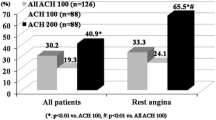Abstract
Intracoronary acetylcholine (ACh) testing has become popular in the world as a spasm provocation test as well as an ergonovine test. Intracoronary ACh test based on the Japanese Circulation Society guidelines is necessary to insert a temporary pace maker (PM). We analyzed the ACh spasm provocation test procedures retrospectively. We performed 1829 ACh spasm provocation testing during 28 years. We investigated the procedural approach sites of artery and vein. Femoral artery and vein approach, brachial artery and femoral vein approach, brachial artery and vein approach, radial artery and brachial vein approach, radial artery and femoral vein approach were performed in 292 patients (16.0%), 498 patients (27.2%), 589 patients (32.2%), 252 patients (13.8%), and 175 patients (9.6%), respectively. We could perform the ACh testing by the femoral artery and brachial artery in all patients, while the success rate of radial artery approach was 97.1%. We could also insert the temporary PM by the brachial vein in 94.8% (841/887) of the study patients, whereas we could insert the temporary PM in all femoral vein approach [100% (965/965)]. We experienced the pulmonary embolism by the femoral artery and vein approach in two patients, while we also had the arterio-venous fistula necessary for surgical repair in two patients by the brachial artery and vein approach. Although there was no difference about the procedure-related major complications among the various procedures, we had no pulmonary embolism or arterio-venous fistula by the radial artery and brachial vein approach. Considering the disinfection with povidone iodine, procedural performance or procedure-related complications by the ACh testing, we recommend that radial artery and brachial vein approach is more comfortable method of the future ACh testing not only for patients but also for operators.


Similar content being viewed by others
References
Yasue H, Horio Y, Nakamura N, Fujii H, Imoto N, Sonoda R, Kugiyama K, Obata K, Morikami Y, Kimura T. Induction of coronary artery spasm by acetylcholine in patients with variant angina: possible role of the parasympathetic nervous system in the pathogenesis of coronary artery spasm. Circulation. 1986;74:955–63.
Okumura K, Yasue H, Matsuyama K, Goto K, Miyagi H, Ogawa H, Matsuyama K. Sensitivity and specificity of intracoronary injection of acetylcholine for the induction of coronary artery spasm. J Am Coll Cardiol. 1988;12:883–8.
Okumura K, Yasue H, Horio Y, Takaoka K, Matsuyama K, Kugiyama K, Fujii H, Morikami Y. Multivessel coronary spasm in patients with variant angina: a study with intracoronary injection of acetylcholine. Circulation. 1988;77:535–42.
Sueda S, Kohno H, Ochi T, Uraoka T, Tsunemitus K. Overview of the pharmacological spasm provocation test: comparisons between acetylcholine and ergonvoine. J Cardiol. 2017;69:57–65.
Sueda S, Kohno H, Ochi T, Uraoka T. Overview of the acetylcholine spasm provocation test. Clin Cardiol. 2015;38:430–8.
JCS joint working group. Guidelines for diagnosis and treatment of patients with vasospastic angina (Coronary spastic angina) (JCS 2013). Circ J. 2014;78:2779–801.
Ong P, Athabasiadis A, Borgulya G, Mahrholdt H, Kaski JC, Secctem U. High prevalence of a pathological reponse to acetylcholine testing in patients with stable angina pectoris and unobstructed coronary arteries: the ACOVA study. J Am Coll Cardiol. 2012;59:655–62.
Ong P, Athanasiadis A, Borgulya G, Voksi I, Bastiaenen R, Kubik S, Hill S, Schaufele T, Mahrholdt H, Kaski JC, Sechtem U. Clinical usefulness, angiographic characteristics, and safety evaluation of intracoronary acetylcholine provocation testing among 921 consecutive white patients with unobstructed coronary arteries. Circulation. 2014;129:1723–30.
Sueda S, Kohno H. The acetylcholine administration time plays the key role for provoked spasm in the spasm provocation test. J Cardiol. 2017;70:141–6.
Sueda S, Oshita A, Izoe Y, Kohno H, Fukuda H, Uraoka T. Coronary artery spasm provocation test by simultaneous brachial artery and vein approach with the Tometakun hemostat. Jpn J Interv Cardiol. 2007;22:510–3.
Sueda S, Fujimoto K, Sasaki Y, Sakaue T, Habara H, Kohno H. Acetylcholine spasm provocation test by trans-radial artery and brachial vein approach. Cathe Cardiovasc Interv. 2018. https://doi.org/10.1002/ccd27970.
Funding
None.
Author information
Authors and Affiliations
Corresponding author
Ethics declarations
Conflict of interest
The authors declare that they have no conflicts of interest.
Research involving human participants and/or animals
The study protocol complied with the Declaration of Helsinki.
Informed consent
Written informed consent about performing the ACh spasm provocation tests was obtained from all patients.
Additional information
Publisher's Note
Springer Nature remains neutral with regard to jurisdictional claims in published maps and institutional affiliations.
Rights and permissions
About this article
Cite this article
Sueda, S., Kohno, H. Transitional changes of acetylcholine spasm provocation test procedures. Cardiovasc Interv and Ther 35, 321–326 (2020). https://doi.org/10.1007/s12928-019-00624-7
Received:
Accepted:
Published:
Issue Date:
DOI: https://doi.org/10.1007/s12928-019-00624-7




